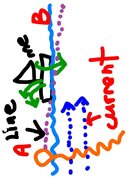Was the boat moored to the buoy, or were they running a live boat and dropping divers up current of the buoy? In the former case the boat crew are supposed to tie a trailing current line into the descent line so that divers can grab onto that and pull themselves forward.
In choppy surface conditions it can sometimes be easier to descend at the stern of the boat and swim underwater to the descent line at the bow. Just be careful to get deep enough so you don't smack your head on the hull or props. And if you're straining to make forward progress then don't exhaust yourself and blow through all your gas just swimming to the line; come back to the stern and ask for help or abort the dive.
If you can get a DPV and associated training then that makes diving in strong currents a lot more fun and easy. But that isn't always a practical option.







